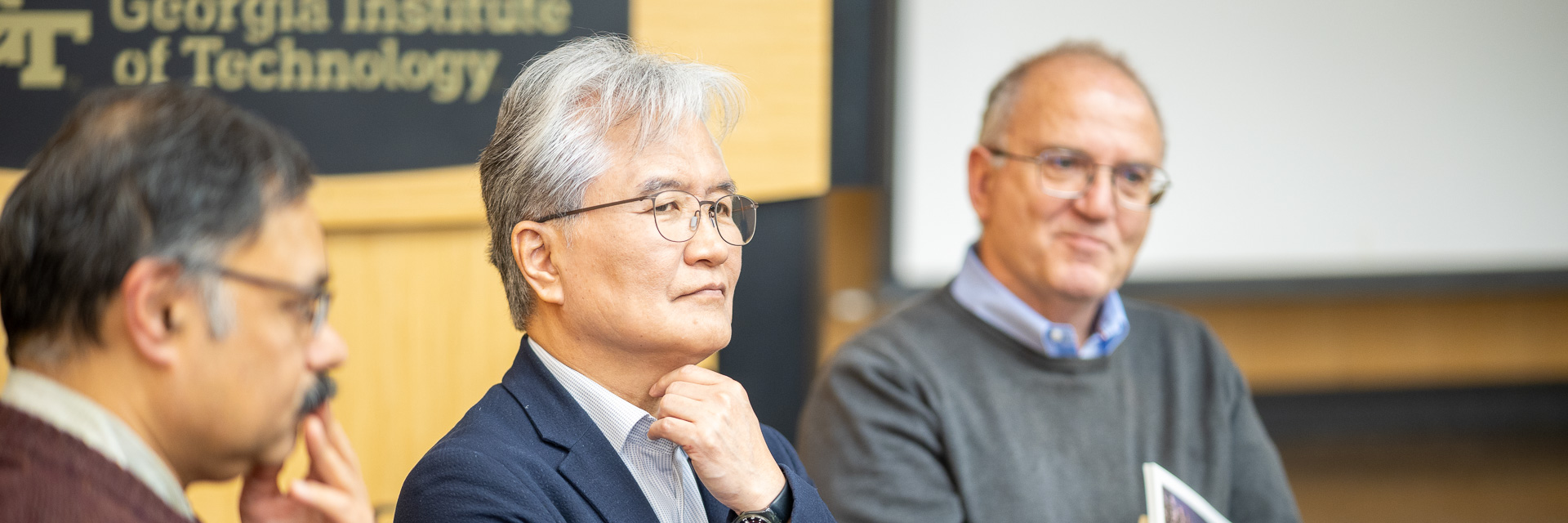
Sung Hong Kim Preserves the Ideas of Architecture
Sung Hong Kim Preserves the Ideas of Architecture
By Wes McRae and Ann Hoevel -- Atlanta, GA
Students and faculty of the School of Architecture joined alumnus Sung Hong Kim (Ph.D. Architecture 1997) to understand how to preserve and share the ideas of architecture in a culture.
"When we talk about the many paths to architectural practice, we sometimes forget the role and importance of intellectuals who actually work to bring architecture to public attention," said John Peponis, professor in the School of Architecture. "But they help us all rethink the position of architecture within culture and society."
Kim, chosen as director of the founding exhibition in the upcoming Korean Museum of Urbanism and Architecture, grappled with the question of what it even means to have a museum of architecture. "The fundamental problem of an architecture museum is the impossibility of bringing the actual building into the museum spaces," he said.
"Images, drawings and information on architecture can be transmitted in books, magazines, and social media platforms," Kim said. "But the end of architecture design is a building, which has a specific site and is anchored to the land."
Architectural Museums
"The museum must represent the here and now of the location and place, so the architectural issues, ideas, and solutions need to be presented in creative and innovative ways."
An architectural museum also has a responsibility present the context of the building, Kim said. "The museum also embodies the collective memory of the location, so history has to be reinterpreted critically."
Kim has been thinking about the preservation and dissemination of the ideas of architecture since his days as a student in the architecture program at Tech. "While I was a student here, I did an inventory and catalog of the drawings and student projects stored in files here. And the projects were beautiful drawings, reflecting the early discipline of modernism and some of the postmodern languages."
"I didn't realize it at the time, but now I realize that the student job at Georgia Tech was the beginning of my interest in the idea of the museum."
Kim has built on this foundation of curating architectural ideas while immersed in the emerging architectural tradition of South Korea. "In 2007, Kim was the curator of the first exhibition of contemporary Korean architecture outside Korea, in the Museum of Architecture in Frankfurt, which was at the time one of the strongest venues for discussing architecture," Peponis said. "Out of that came his book, Megacity Network, which is tied to the emergence of Korean architecture on the international scene."
"In 2016, Kim wrote The FAR Game, discussing the social and regulatory constraints in Korea, and innovative ways Korean architects were able to experiment and create quite unique forms."
"Ever since he has been on the editorial team of SPACE magazine, which is probably the most glamorous architectural monthly publication in Korean," Peponis said.
Being a Georgia Tech Architecture Student
Kim had a scholarship from the Korean government for three years of graduate school. For two of those years he was a UC Berkeley, where he got a Masters of Architecture degree. By the time he came to Georgia Tech in 1980 for his Ph.D., the money was running out.
"I was desperate to find the financial support funding," he said, "and at the time was very difficult to do that, particularly in the Architecture program. And I was lucky that one of my Ph.D. friends, Richard Hayes, asked me to work with him on a rudimentary inventory of student drawings that were in the storage closet called 'The Morgue'."
A research unit of the College of Design (at that time called the College of Architecture) funded the cataloging project. "We did the inventory, recording size and colors of the student work, the mediums, which modern architecture principle they reflected, some of them displayed postmodern languages. And we got paid to do it, and at some point we had to move all these drawings to the Heffernan House."
"So because of this, this job, I could finish my PhD.," Kim said, "and now I embody all this archiving and curating. The beginning of my career was right here. So I really thank Georgia Tech because of this job. And for Dean Galloway's support."
Each day, as he logged the examples of student work, it was like, "reading the history of architecture education at Georgia Tech," Kim said. "If you look at the total all these drawings, you will understand the evolution of architectural principles. Beautiful."
Questions?
Contact Us